Ielts academic Reading 67
Educating Psyche by Bernie Neville is a book which looks at radical new approaches to learning, describing the effects of emotion, imagination and the unconscious on learning. One the theory discussed in the book is that proposed by George Lozanov, which focuses on the power of suggestion.
Lozanov's instructional technique is based on the evidence that the connections made in the brain through unconscious processing (which he calls non-specific mental reactivity) are more durable than those mad through conscious processing. Besides the laboratory evidence for this, we know from our experience that we often remember what we have perceived peripherally, long after we have forgotten what we set out to learn if we think of a book we studied months or years ago, we will find it easier to recall peripheral details. The colour, the binding, the typeface, the table at the library where we sat while studying it than the content on which were concentrating If we think of a lecture we listened to with great concentration, we will recall the lecturer's appearance and mannerisms, our place in the auditorium, the failure of the air-conditioning, much more easily than the ideas we went to learn. Even if these peripheral details are a bit elusive, they come back readily in hypnosis or when we relive the event imaginatively, as in psychodrama. The details of the content of the lecture, on the other hand, seem to have gone forever.
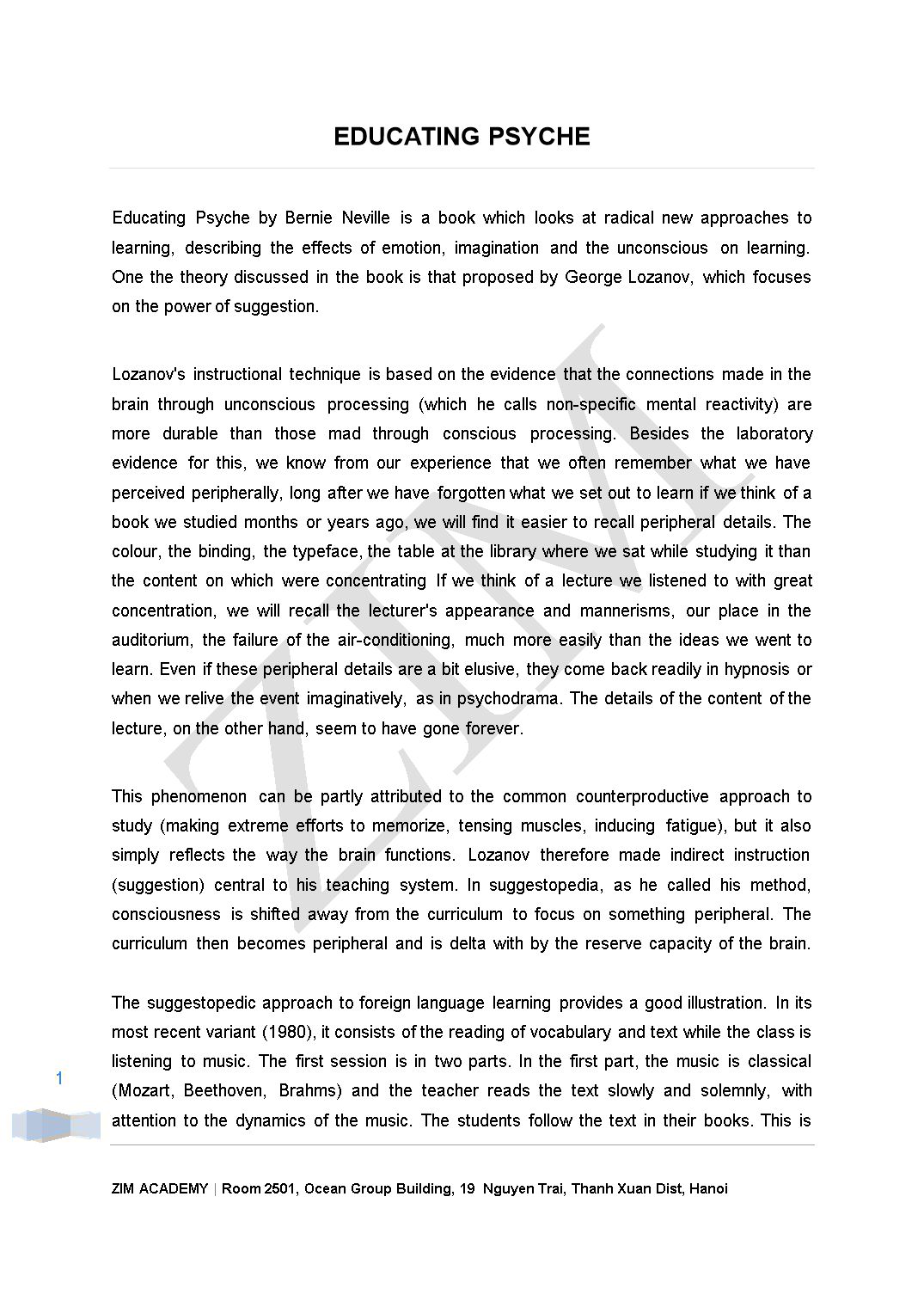
Trang 1
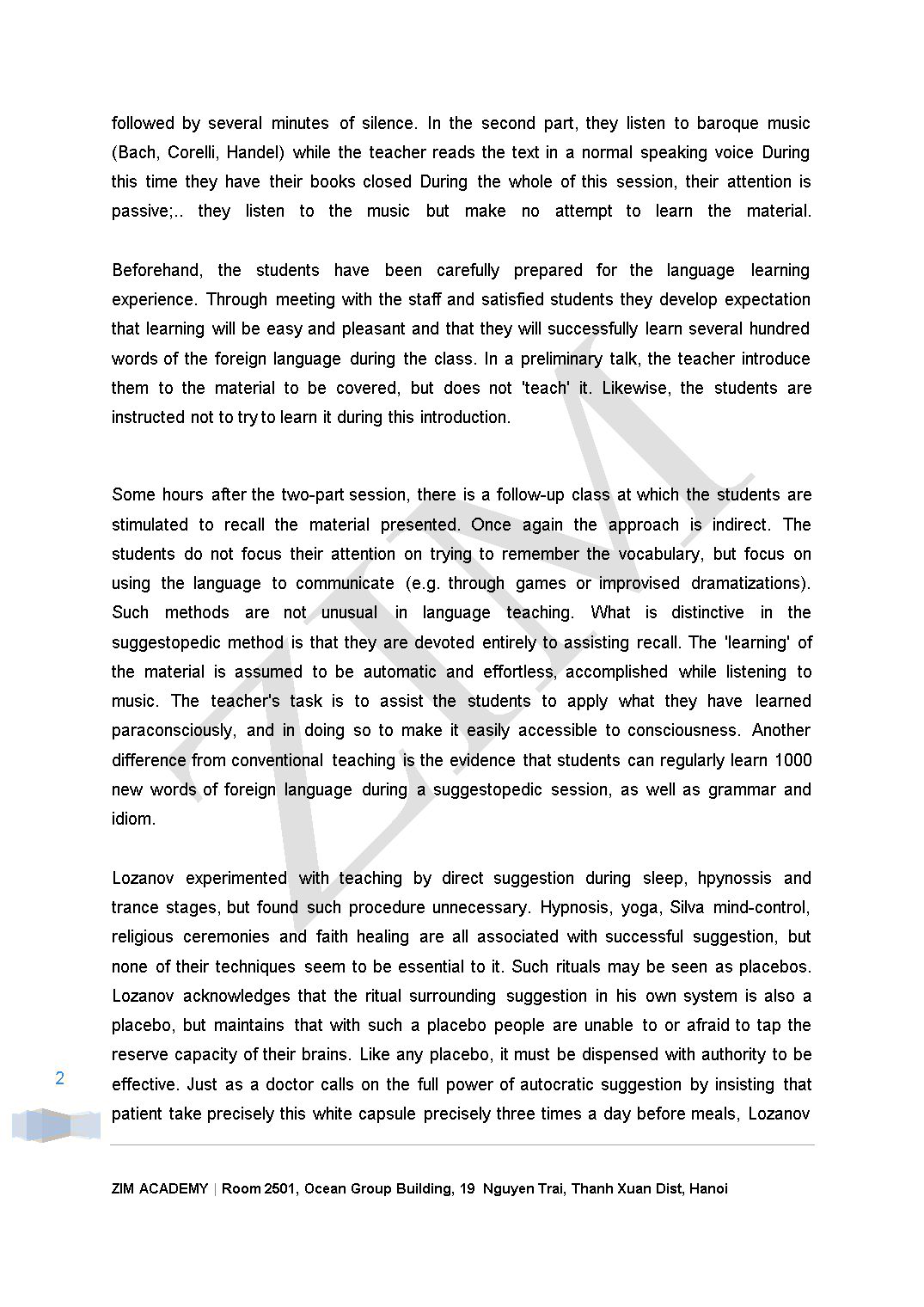
Trang 2
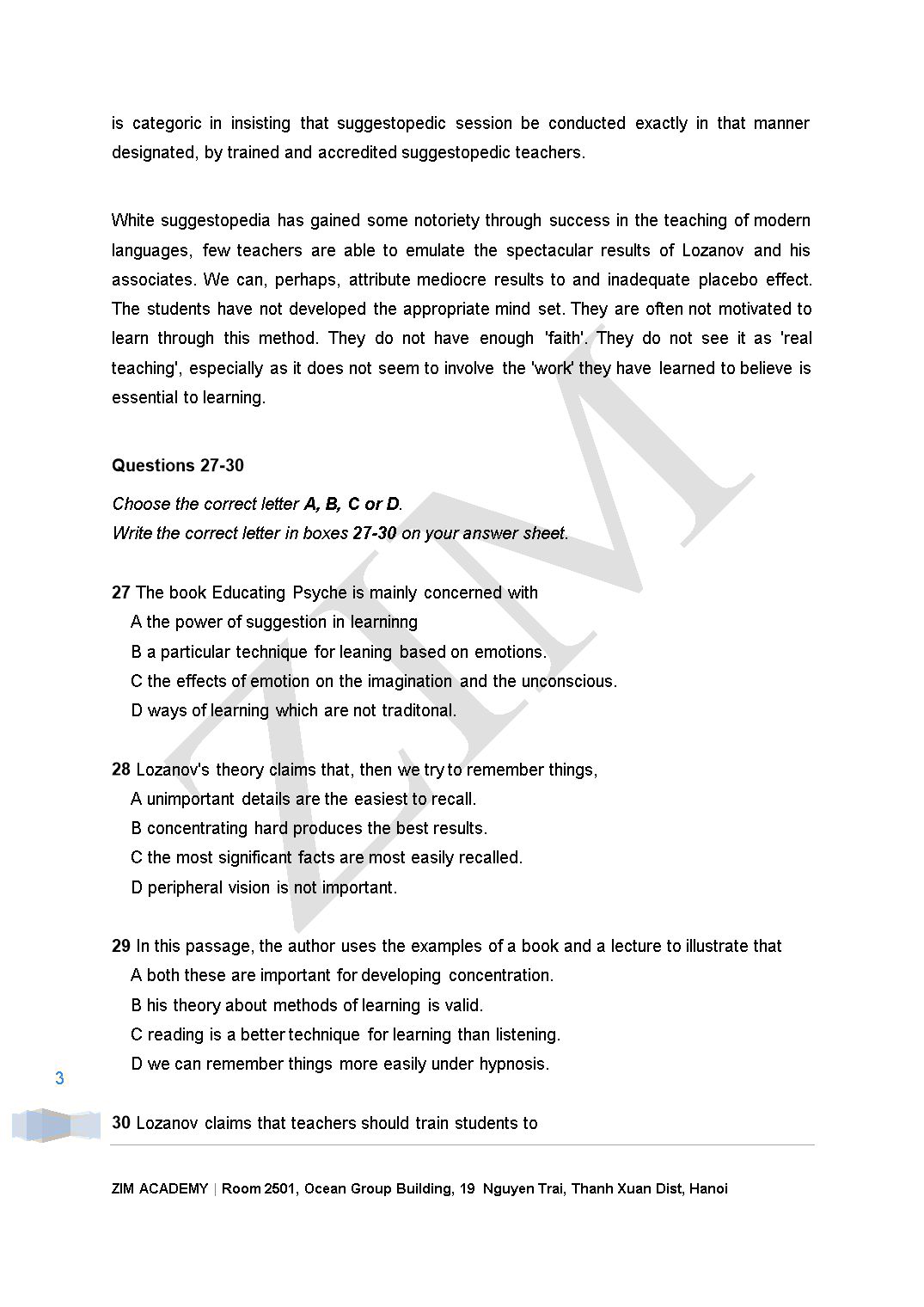
Trang 3

Trang 4
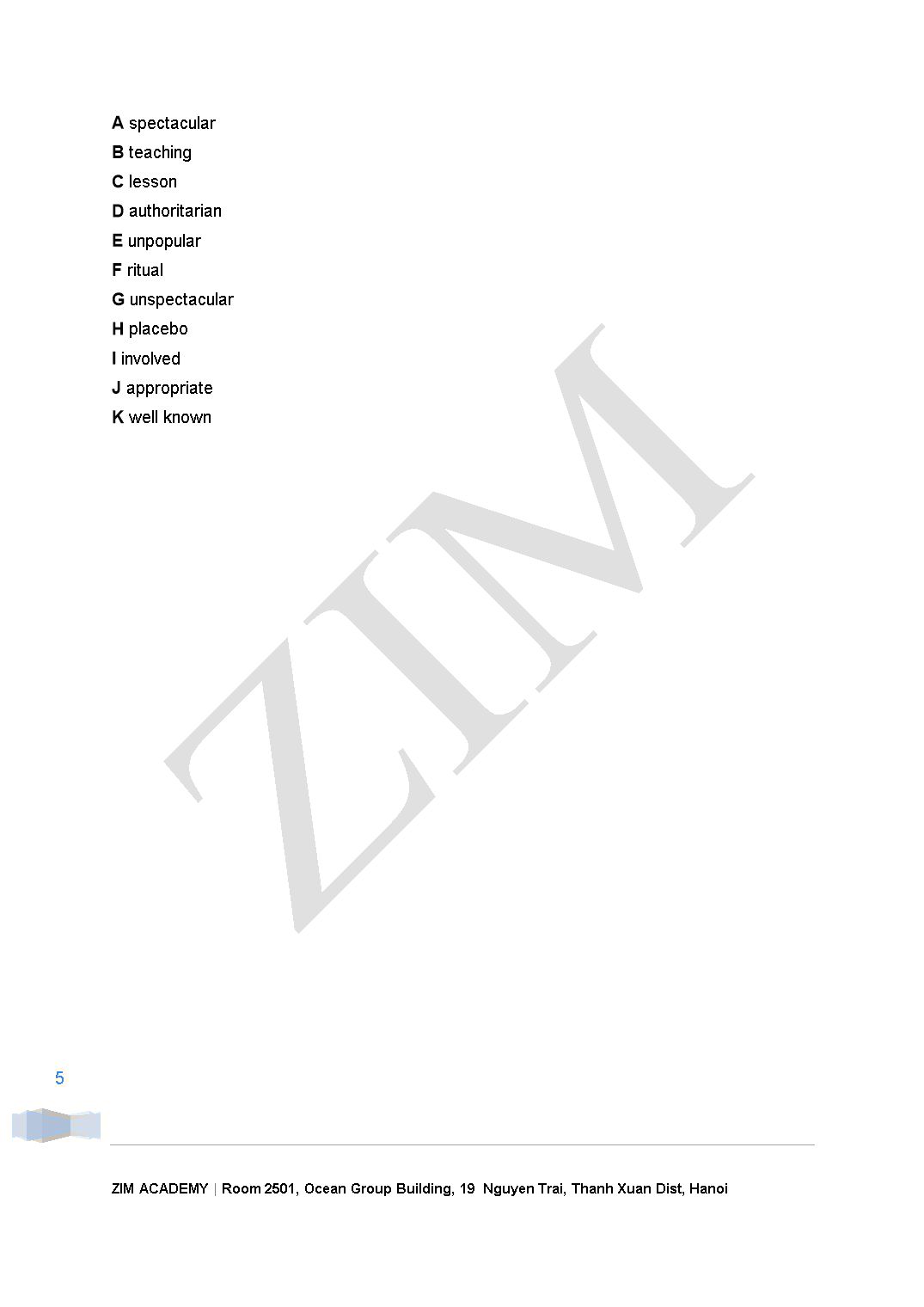
Trang 5
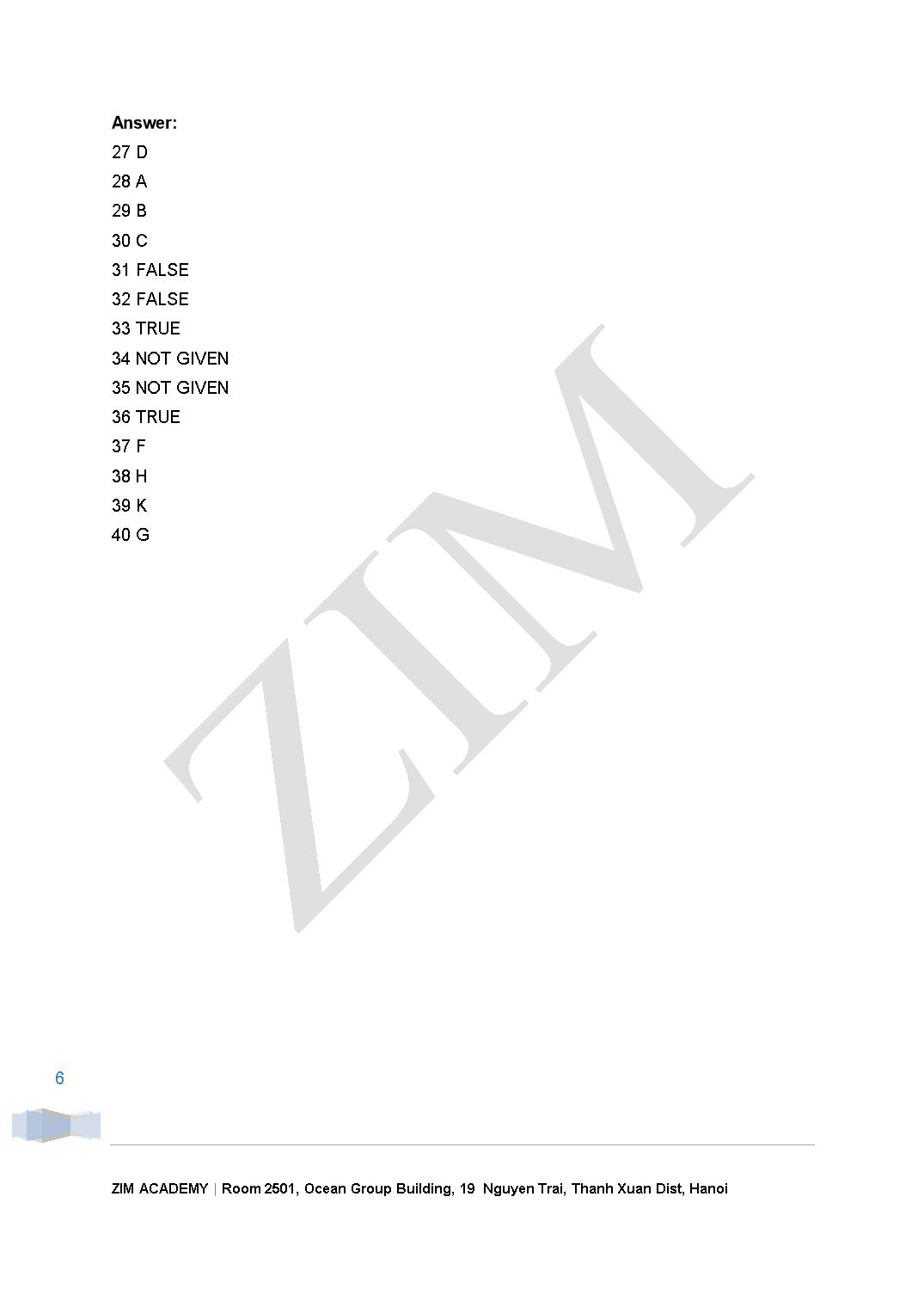
Trang 6
Tóm tắt nội dung tài liệu: Ielts academic Reading 67
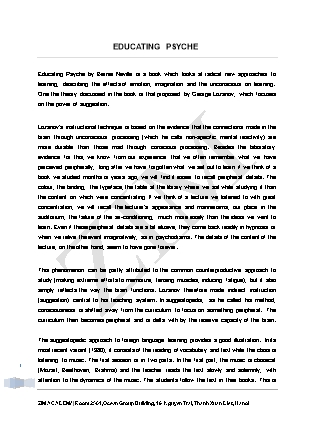
EDUCATING PSYCHE Educating Psyche by Bernie Neville is a book which looks at radical new approaches to learning, describing the effects of emotion, imagination and the unconscious on learning. One the theory discussed in the book is that proposed by George Lozanov, which focuses on the power of suggestion. Lozanov's instructional technique is based on the evidence that the connections made in the brain through unconscious processing (which he calls non-specific mental reactivity) are more durable than those mad through conscious processing. Besides the laboratory evidence for this, we know from our experience that we often remember what we have perceived peripherally, long after we have forgotten what we set out to learn if we think of a book we studied months or years ago, we will find it easier to recall peripheral details. The colour, the binding, the typeface, the table at the library where we sat while studying it than the content on which were concentrating If we think of a lecture we listened to with great concentration, we will recall the lecturer's appearance and mannerisms, our place in the auditorium, the failure of the air-conditioning, much more easily than the ideas we went to learn. Even if these peripheral details are a bit elusive, they come back readily in hypnosis or when we relive the event imaginatively, as in psychodrama. The details of the content of the lecture, on the other hand, seem to have gone forever. This phenomenon can be partly attributed to the common counterproductive approach to study (making extreme efforts to memorize, tensing muscles, inducing fatigue), but it also simply reflects the way the brain functions. Lozanov therefore made indirect instruction (suggestion) central to his teaching system. In suggestopedia, as he called his method, consciousness is shifted away from the curriculum to focus on something peripheral. The curriculum then becomes peripheral and is delta with by the reserve capacity of the brain. The suggestopedic approach to foreign language learning provides a good illustration. In its most recent variant (1980), it consists of the reading of vocabulary and text while the class is listening to music. The first session is in two parts. In the first part, the music is classical (Mozart, Beethoven, Brahms) and the teacher reads the text slowly and solemnly, with attention to the dynamics of the music. The students follow the text in their books. This is followed by several minutes of silence. In the second part, they listen to baroque music (Bach, Corelli, Handel) while the teacher reads the text in a normal speaking voice During this time they have their books closed During the whole of this session, their attention is passive;.. they listen to the music but make no attempt to learn the material. Beforehand, the students have been carefully prepared for the language learning experience. Through meeting with the staff and satisfied students they develop expectation that learning will be easy and pleasant and that they will successfully learn several hundred words of the foreign language during the class. In a preliminary talk, the teacher introduce them to the material to be covered, but does not 'teach' it. Likewise, the students are instructed not to try to learn it during this introduction. Some hours after the two-part session, there is a follow-up class at which the students are stimulated to recall the material presented. Once again the approach is indirect. The students do not focus their attention on trying to remember the vocabulary, but focus on using the language to communicate (e.g. through games or improvised dramatizations). Such methods are not unusual in language teaching. What is distinctive in the suggestopedic method is that they are devoted entirely to assisting recall. The 'learning' of the material is assumed to be automatic and effortless, accomplished while listening to music. The teacher's task is to assist the students to apply what they have learned paraconsciously, and in doing so to make it easily accessible to consciousness. Another difference from conventional teaching is the evidence that students can regularly learn 1000 new words of foreign language during a suggestopedic session, as well as grammar and idiom. Lozanov experimented with teaching by direct suggestion during sleep, hpynossis and trance stages, but found such procedure unnecessary. Hypnosis, yoga, Silva mind-control, religious ceremonies and faith healing are all associated with successful suggestion, but none of their techniques seem to be essential to it. Such rituals may be seen as placebos. Lozanov acknowledges that the ritual surrounding suggestion in his own system is also a placebo, but maintains that with such a placebo people are unable to or afraid to tap the reserve capacity of their brains. Like any placebo, it must be dispensed with authority to be effective. Just as a doctor calls on the full power of autocratic suggestion by insisting that patient take precisely this white capsule precisely three times a day before meals, Lozanov is categoric in insisting that suggestopedic session be conducted exactly in that manner designated, by trained and accredited suggestopedic teachers. White suggestopedia has gained some notoriety through success in the teaching of modern languages, few teachers are able to emulate the spectacular results of Lozanov and his associates. We can, perhaps, attribute mediocre results to and inadequate placebo effect. The students have not developed the appropriate mind set. They are often not motivated to learn through this method. They do not have enough 'faith'. They do not see it as 'real teaching', especially as it does not seem to involve the 'work' they have learned to believe is essential to learning. Questions 27-30 Choose the correct letter A, B, C or D. Write the correct letter in boxes 27-30 on your answer sheet. 27 The book Educating Psyche is mainly concerned with A the power of suggestion in learninng B a particular technique for leaning based on emotions. C the effects of emotion on the imagination and the unconscious. D ways of learning which are not traditonal. 28 Lozanov's theory claims that, then we try to remember things, A unimportant details are the easiest to recall. B concentrating hard produces the best results. C the most significant facts are most easily recalled. D peripheral vision is not important. 29 In this passage, the author uses the examples of a book and a lecture to illustrate that A both these are important for developing concentration. B his theory about methods of learning is valid. C reading is a better technique for learning than listening. D we can remember things more easily under hypnosis. 30 Lozanov claims that teachers should train students to A memorise details of the curriculum. B develop their own sets of indirect instructions. C think about something other than the curriculum content. D avoid overloading the capacity of the brain. Questions 31-36 Do the following statement agree with the information given in Reading Passage? In boxes 31-36 on your answer sheet, write: TRUE if the statement agrees with the information FALSE if the statement contradicts the information NOT GIVEN if there is no information on this 31 In the example of suggestopedic teaching in the fourth paragraph, the only variable that chagnes is the music. 32 Prior to the suggestopedia class, students are made aware that the language experience will be demanding. 33 In the follow-up class, the teaching activities are similar to those used in conventional classes. 34 As an indirect benefit, students notice improvements in their memory. 35 Teachers say they prefer suggestopedia to traditional approaches to language teaching. 36 Students in a suggestopedia class retain more new vocabulary than those in ordinary classes. Questions 37-40 Complete the summary using the list of words, A - K, below. Write the correct letter A -K in boxes 37-40 on your answer sheet. Sugestopedia uses a less direct method of suggestion than other techniques such as hypnosis. However, Lozanov admits that a certain amount of 37.................. is necessary in order to convince students, even if this is just a 38......................... Futhermore, if the method is to succeed, teachers must follow a set procedure. Although Lozanov's method has become quite 39..................., the result of most other teachers using this method have been 40........................ A spectacular B teaching C lesson D authoritarian E unpopular F ritual G unspectacular H placebo I involved J appropriate K well known Answer: 27 D 28 A 29 B 30 C 31 FALSE 32 FALSE 33 TRUE 34 NOT GIVEN 35 NOT GIVEN 36 TRUE 37 F 38 H 39 K 40 G
File đính kèm:
 ielts_academic_reading_67.doc
ielts_academic_reading_67.doc

